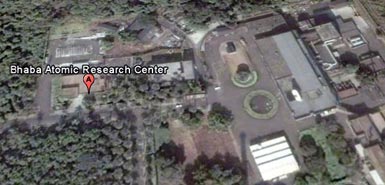
Aerial photographs of the Bhabha Atomic Research Centre on Google Earth
An Indian Court has been called to ban Google Earth amid suggestions the online satellite imaging was used to help plan the terror attacks that killed more than 170 people in Mumbai last month.
A petition entered at the Bombay High Court alleges that the Google Earth service, “aids terrorists in plotting attacks”. Advocate Amit Karkhanis has urged the court to direct Google to blur images of sensitive areas in the country until the case is decided.
There are indications that the gunmen who stormed Mumbai on November 26, and the people trained them, were technically literate. The group appears to have used complex GPS systems to navigate their way to Mumbai by sea. They communicated by satellite phone, used mobile phones with several different SIM cards, and may have monitored events as the siege unfolded via handheld Blackberry web browsers.
Police in Mumbai have said the terrorists familiarised themselves with the streets of Mumbai’s financial capital using satellite images, according to the sole gunman to be captured alive. The commandos who stormed the Taj Mahal Palace hotel in Mumbai said the militants had made a beeline for the building’s CCTV control room.
The legal petition also follows unconfirmed reports that Faheem Ahmed Ansari, a suspected militant who was arrested in the northern state of Uttar Pradesh in February, said he was shown maps of Indian locations on Google Earth by members of Lashkar-e-Taiber, the Pakistan-based terrorist faction that Indian officials are convinced was behind the Mumbai attacks.
Ansari was carrying a fake Pakistani passport and a list and maps of nine targets in southern Mumbai, including the Taj Mahal hotel and other sites attacked last month, a senior police officer told The Times.
Security agencies have called for the wealth of data available on Google Earth to be limited for several years amid fears the freely available application may prove invaluable for militants planning terrorist attacks.
In 2005, the operators of Australia’s nuclear reactor at Lucas Heights called on the internet giant to censor images of the plant, warning that the images could be used by terrorists.
Earlier, the satellite photographs of the installation would have been available only to a handful of government agencies and NASA, they said.
In the same year, it was reported that Google omitted to blur the roof of the White House in Washington when it updated the images available on Google Earth – something it had done previously.
South Korea and Thailand also complained after the layout of air bases was revealed.
The Mumbai terrorists concentrated their attacks in south Mumbai, a popular tourist location. However, the plea filed with the Bombay High Court claims that Google Earth includes “absolutely no control to prevent misuse or limit access” to details of nearby sensitive locations, such as the Bhabha Atomic Research Centre.
The complaint comes just weeks after India said it would launch its own version of Google Earth.
The project, dubbed Bhuvan (Sanskrit for Earth), is being developed by the Indian Space Research Organisation (Isro), which is based in Bangalore, the Silicon Valley of the subcontinent.
It comes as India redoubles its efforts to reap profits from its 45-year-old space programme, long criticised as a drain on a country where 700 million people live on USD2 a day or less.
Bhuvan will use a network of satellites to create a high-resolution, birds-eye view of India – and later, possibly, the rest of the world – that will be accessible at no cost online and will compete with Google.
Isro officials say Bhuvan will provide images of far greater resolution than are currently available online – particularly of the subcontinent, a region where large areas remain virtually unmapped.
The agency intends to refresh its images every year – a feature that would give it an edge over its biggest rival and help keep track of the frenetic pace at which India’s cities are growing.
About 2.5 million people used Google Earth in the UK last month, according to Neilsen, the web analysts, making it the web’s seventh most popular application behind tools such as Apple’s iTunes (fourth with 5.7 million users) and Windows Live Messenger (first with 14.8 million).
December 9, 2008
Rhys Blakely in Mumbai
Source: Times Online
1 thought on “Google Earth accused of aiding terrorists”